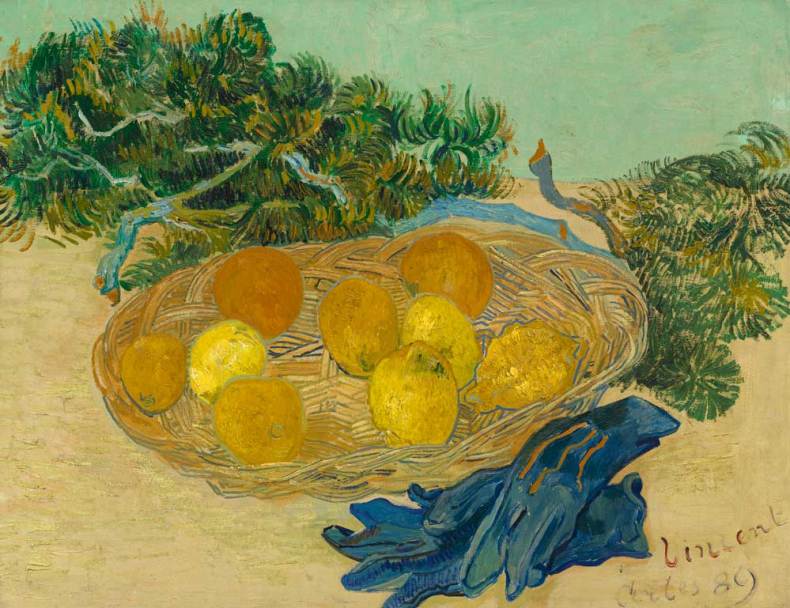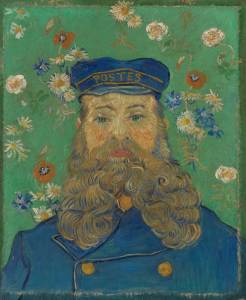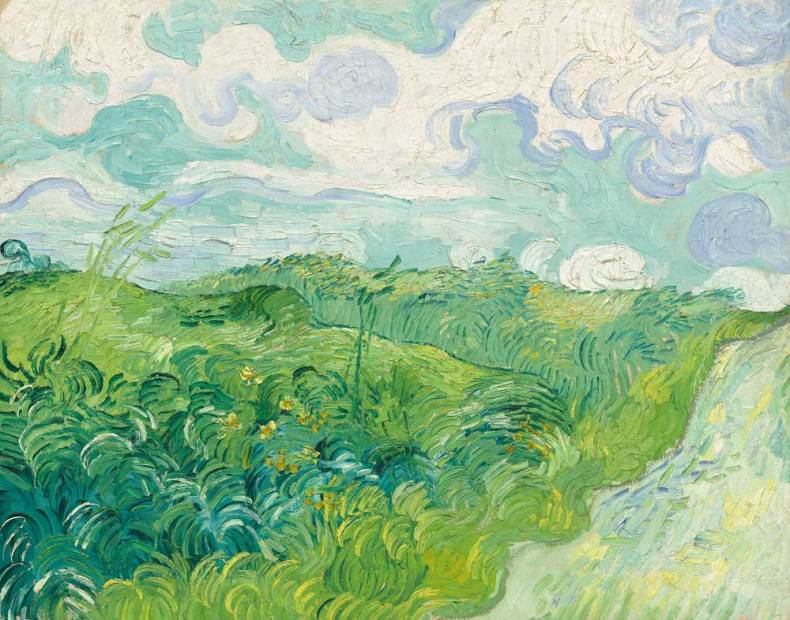It’s not often that a crowd of curators stands waiting to see pieces of art; they usually have ways of getting doors opened. But that’s what happened on Friday 23 May at the National Gallery of Art in Washington. Following the death of Paul Mellon’s widow, Rachel ‘Bunny’ Lambert Mellon, at her estate in Virginia on 17 March, the final tranche of the massive Paul Mellon bequest to the gallery arrived at its back door, all 62 pieces.
First the registrars counted it in, then the conservators took a quick inspection. At 11am the doors were opened. ‘You can imagine the hoard of curators waiting to go in’, says Kimberly Jones, Assistant Curator of French Paintings, relishing the memory. ‘I’ve been at the National Gallery for 19 years and had never seen any of these paintings, nor had most of my colleagues. The Van Gogh, for instance, was last was last seen in public in 1966. I was a year old at that time!’

Still Life of Oranges and Lemons with Blue Gloves (1889), Vincent van Gogh. National Gallery of Art, Washington, Collection of Mr and Mrs Paul Mellon
Van Gogh’s Still Life of Oranges and Lemons with Blue Gloves (1889) joins a recent Mellon bequest, Van Gogh’s Green Wheat Fields, Auvers (1890), his Portrait of Joseph Roulin (1889) lent by the Kröller-Müller Museum in the Netherlands, and six other National Gallery Van Gogh pictures – all of them made during the last three years of the artist’s life – in a pre-planned show opening there on 7 June. The show enables a second, more intimate reunion: the loaned portrait of postman Joseph Roulin joins the gallery’s picture of Joseph’s baby.

Portrait of Joseph Roulin (1889), Vincent van Gogh. Kröller-Müller Museum, Otterlo, The Netherlands
The new Mellon arrivals had been laid out on tables or hung on screens. ‘I walked in and saw a big painting by Degas of horses before a race’, says Jones. ‘I’d only known it from black and white photographs. I said “Wow! It’s green! And so big!” I’ve seen a lot of Degas, but this one was impressive.’ Entitled The Riders and painted around 1885, it depicts a subject loved by both Degas and Mellon. It joins Mellon’s other gifts of Degas sculptures and drawings related to horse racing, in one of the world’s finest holdings of the artist.
The Pittsburgh industrialist and financier Andrew Mellon, who was Ambassador to the United Kingdom 1932–3, founded the National Gallery of Art in 1937. It was he who laid down the requirement that whatever the state of the economy the gallery would always remain free of charge, a rarity in the US. Its collection has been formed entirely by private donations.
Andrew’s son Paul always had a special affection for the gallery, consistently giving some of the cream of his collection. (Top-flight work also went to Yale, his alma mater). After his death in 1999, 110 works remained for his wife to enjoy until her death, although their final destination was already decided. As the years passed, she began to give them – Van Gogh’s Green Wheat Field, Auvers arrived at the gallery last year.

Green Wheat Fields, Auvers (1890), Vincent van Gogh. National Gallery of Art, Washington, Collection of Mr and Mrs Paul Mellon
The 62 works are a roll call of 19th- and 20th-century European and American painters; canvases by Manet, Monet, Morisot and Magritte, by Boudin, Bonnard and Braque, by Fremiet and Forain, by Pissarro and Prendergast, and others. All collected with Mellon’s discerning eye for quality.
Jones is especially pleased about the arrival of 12 oil sketches by Georges Seurat to join four paintings and one drawing already in the collection. ‘Imagine! Not just one. Twelve! Twelve beautiful little oil sketches. Seurat was 32 when he died, leaving only about 200 paintings in all. So, for us to have 16 is so exciting because they are all late 1882 to 1885 and use a wide range of techniques and palettes. It presents a great opportunity to study his work.’
Paul and Bunny Mellon have donated 1,168 works of art to the gallery since 1964. No surprise, then, that there is to be an exhibition about the Mellon gifts in 2016.
‘Celebrating Van Gogh at the NGA’ is at the National Gallery of Art, Washington, from 8 June–7 September.

Paul Mellon’s final gift to the National Gallery of Art, Washington
Still Life of Oranges and Lemons with Blue Gloves (1889), Vincent van Gogh. National Gallery of Art, Washington, Collection of Mr. and Mrs. Paul Mellon
Share
It’s not often that a crowd of curators stands waiting to see pieces of art; they usually have ways of getting doors opened. But that’s what happened on Friday 23 May at the National Gallery of Art in Washington. Following the death of Paul Mellon’s widow, Rachel ‘Bunny’ Lambert Mellon, at her estate in Virginia on 17 March, the final tranche of the massive Paul Mellon bequest to the gallery arrived at its back door, all 62 pieces.
First the registrars counted it in, then the conservators took a quick inspection. At 11am the doors were opened. ‘You can imagine the hoard of curators waiting to go in’, says Kimberly Jones, Assistant Curator of French Paintings, relishing the memory. ‘I’ve been at the National Gallery for 19 years and had never seen any of these paintings, nor had most of my colleagues. The Van Gogh, for instance, was last was last seen in public in 1966. I was a year old at that time!’
Still Life of Oranges and Lemons with Blue Gloves (1889), Vincent van Gogh. National Gallery of Art, Washington, Collection of Mr and Mrs Paul Mellon
Van Gogh’s Still Life of Oranges and Lemons with Blue Gloves (1889) joins a recent Mellon bequest, Van Gogh’s Green Wheat Fields, Auvers (1890), his Portrait of Joseph Roulin (1889) lent by the Kröller-Müller Museum in the Netherlands, and six other National Gallery Van Gogh pictures – all of them made during the last three years of the artist’s life – in a pre-planned show opening there on 7 June. The show enables a second, more intimate reunion: the loaned portrait of postman Joseph Roulin joins the gallery’s picture of Joseph’s baby.
Portrait of Joseph Roulin (1889), Vincent van Gogh. Kröller-Müller Museum, Otterlo, The Netherlands
The new Mellon arrivals had been laid out on tables or hung on screens. ‘I walked in and saw a big painting by Degas of horses before a race’, says Jones. ‘I’d only known it from black and white photographs. I said “Wow! It’s green! And so big!” I’ve seen a lot of Degas, but this one was impressive.’ Entitled The Riders and painted around 1885, it depicts a subject loved by both Degas and Mellon. It joins Mellon’s other gifts of Degas sculptures and drawings related to horse racing, in one of the world’s finest holdings of the artist.
The Pittsburgh industrialist and financier Andrew Mellon, who was Ambassador to the United Kingdom 1932–3, founded the National Gallery of Art in 1937. It was he who laid down the requirement that whatever the state of the economy the gallery would always remain free of charge, a rarity in the US. Its collection has been formed entirely by private donations.
Andrew’s son Paul always had a special affection for the gallery, consistently giving some of the cream of his collection. (Top-flight work also went to Yale, his alma mater). After his death in 1999, 110 works remained for his wife to enjoy until her death, although their final destination was already decided. As the years passed, she began to give them – Van Gogh’s Green Wheat Field, Auvers arrived at the gallery last year.
Green Wheat Fields, Auvers (1890), Vincent van Gogh. National Gallery of Art, Washington, Collection of Mr and Mrs Paul Mellon
The 62 works are a roll call of 19th- and 20th-century European and American painters; canvases by Manet, Monet, Morisot and Magritte, by Boudin, Bonnard and Braque, by Fremiet and Forain, by Pissarro and Prendergast, and others. All collected with Mellon’s discerning eye for quality.
Jones is especially pleased about the arrival of 12 oil sketches by Georges Seurat to join four paintings and one drawing already in the collection. ‘Imagine! Not just one. Twelve! Twelve beautiful little oil sketches. Seurat was 32 when he died, leaving only about 200 paintings in all. So, for us to have 16 is so exciting because they are all late 1882 to 1885 and use a wide range of techniques and palettes. It presents a great opportunity to study his work.’
Paul and Bunny Mellon have donated 1,168 works of art to the gallery since 1964. No surprise, then, that there is to be an exhibition about the Mellon gifts in 2016.
‘Celebrating Van Gogh at the NGA’ is at the National Gallery of Art, Washington, from 8 June–7 September.
Unlimited access from just $16 every 3 months
Subscribe to get unlimited and exclusive access to the top art stories, interviews and exhibition reviews.
Share
Recommended for you
Meditations on Film: Bill Viola at the Grand Palais
Meditative and mysterious, Bill Viola’s video work asks timeless questions
Not just for the posh: rebranding History of Art
I’ve never quite understood why History of Art should have such a bad reputation
Baron Lorne Thyssen-Bornemisza de Kászon: April Apollo
Baron Lorne Thyssen-Bornemisza speaks to Susan Moore about the opening of Kallos Gallery in London and his love of antiquities